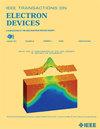基于人工神经网络的氧化薄膜晶体管及电路建模
IF 3.2
2区 工程技术
Q2 ENGINEERING, ELECTRICAL & ELECTRONIC
引用次数: 0
摘要
氧化物薄膜晶体管(TFTs)近年来发展迅速,在显示驱动器、动态随机存取存储器等领域的应用越来越广泛。与大量的实验工作相比,在建模方面开展的工作非常有限,特别是新探索的人工神经网络(ANN)方法,它能够精确建模。本文建立了n型氧化铟镓锌(IGZO)和p型氧化锡(SnO) tft的神经网络模型。我们的人工神经网络模型包括三层神经元,以平衡准确性和复杂性。模拟的TFT电流与实验数据在4个数量级以上的大范围内一致。对于IGZO和SnO晶体管,模型在整个实验电流和电压范围内的相对误差分别不大于0.47%和0.29%。模型预测非测量器件电流的能力也允许进行电路建模,正如预测的氧化物逆变器和非门特性与实验数据之间的一致性所证明的那样。本文章由计算机程序翻译,如有差异,请以英文原文为准。
Oxide Thin-Film Transistor and Circuit Modeling Using Artificial Neural Network
The oxide thin-film transistors (TFTs) have developed rapidly in the past years and are entering more and more commercial applications, such as display drivers and dynamic random access memories. In contrast to a vast amount of experimental work, very limited work has been carried out on the modeling, particularly with the newly explored artificial neural network (ANN) approach, which is capable of precise modeling. Here, ANN models are established for both n-type indium-gallium-zinc oxide (IGZO) and p-type tin monoxide (SnO) TFTs. Our ANN models include three layers of neurons in order to balance the accuracy and the complexity. The modeled TFT currents agree with the experimental data over a wide range of more than four orders of magnitude. The relative error of the model in the entire experimental current and voltage ranges is no more than 0.47% and 0.29% for the IGZO and SnO TFTs, respectively. The ability for the model to predict nonmeasured device current also allows for circuit modeling, as evidenced by the agreement between the predicted oxide inverter and nand gate characteristics and the experimental data.
求助全文
通过发布文献求助,成功后即可免费获取论文全文。
去求助
来源期刊

IEEE Transactions on Electron Devices
工程技术-工程:电子与电气
CiteScore
5.80
自引率
16.10%
发文量
937
审稿时长
3.8 months
期刊介绍:
IEEE Transactions on Electron Devices publishes original and significant contributions relating to the theory, modeling, design, performance and reliability of electron and ion integrated circuit devices and interconnects, involving insulators, metals, organic materials, micro-plasmas, semiconductors, quantum-effect structures, vacuum devices, and emerging materials with applications in bioelectronics, biomedical electronics, computation, communications, displays, microelectromechanics, imaging, micro-actuators, nanoelectronics, optoelectronics, photovoltaics, power ICs and micro-sensors. Tutorial and review papers on these subjects are also published and occasional special issues appear to present a collection of papers which treat particular areas in more depth and breadth.
 求助内容:
求助内容: 应助结果提醒方式:
应助结果提醒方式:


